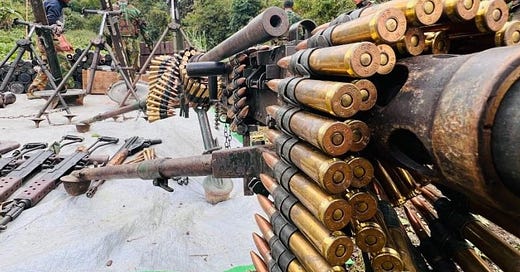Myanmar Junta Looks Increasingly Vulnerable as Rebels Gain Ground
Military now on the run in western borderlands
By: David Scott Mathieson
The rebel forces involved in heavy fighting in northern Myanmar following the unprecedented ‘Operation 1027’ of late October have continued their momentum, with the Three Brotherhood Alliance (3BA) and their allies continuing to take key towns ago from the State Administration Council, the junta that seized power from a democratically elected government in February 2021, and overrun over 200 military bases. Surprisingly, Myanmar’s people making unprecedented gains against a powerful and well-armed dictatorship, which is now in retreat on multiple fronts, having lost hundreds of bases and thousands of soldiers.
Yet an equally stunning military advance has also been playing out in Myanmar’s Western borderlands with India and Bangladesh, as one of the 3BA’s members, the Arakan Army (AA), seized major military installations and the key river trading town of Paletwa in Chin State on January 14. The series of victories not just secures the Arakan Army’s control of the tri-border region and the Kaladan River, but also brings the armed group into a strengthened strategic position in the neighboring Magwe Region. The AA has acknowledged for the first time publicly that non-Rakhine PDF allies they have trained also took part in the operations, which may suggest the possibility of the AA expanding its anti-SAC fight in other theaters.
The Arakan Army and its political wing, the United League of Arakan (ULA), broke a shaky ceasefire several weeks ago with the State Administration Council (SAC) regime following what was clearly a suspension of hostilities to prepare for an inevitable offensive. The Arakan Army’s success is certain to attract the attention of New Delhi, which has long pursued an infrastructure project there.
In recent weeks AA forces have overrun scores of bases in multiple locations, including two significant firebases north of Paletwa. These were all bases the AA tried to seize in early 2020, but were beaten off in some of the heaviest fighting in Rakhine since the AA began to establish a presence there several years before.
The once prodigious AA/ULA conflict communications efforts, mostly through its website and VK channel (it was ‘deplatformed’ by Facebook in early 2019 as a ‘dangerous organization’) were on hiatus during the ‘ceasefire.’ It resumed with gusto following Operation 1027, and the group in recent days has posted multiple satellite photos and images of captured outposts, dramatic weapons including artillery and armored vehicles, and soldiers standing outside the Paletwa headquarters of the military-aligned Union Solidarity and Development Party (USDP) and administrative offices. The commander of the Myanmar army Military Operations Command Number 19 (MOC-19), a brigadier-general, was also captured.
The fighting has also been raging in other townships such as Rathedaung, Pauktaw, Mrauk U, Minbya, and Maungdaw. Sources in Sittwe, the state capital, report routine ‘outgoing’ artillery fire by land-based systems and naval vessels shooting into neighboring Pauktaw, destroying the town marketplace and displacing thousands of civilians. Fighting has also spread to Kyaukphyu, a strategically important coastal town in Central Rakhine, where Chinese energy pipelines come ashore and a major port project crucial to Beijing’s Indian Ocean strategy is ongoing. AA forces staged a rudimentary rocket attack on the nearby Dhanyawadi naval base in early January.
The State Administrative Council has also pursued a land blockade of Rakhine State, limiting access to food supplies and civilian travel in and out. There are increased tensions in the state capital Sittwe as economic conditions deteriorate and the fighting draws closer. The Center for Arakan Studies (CAS) reported that since fighting resumed in November, nearly 500 civilians have been arrested, mostly in Sittwe, and nearly 200 injured and 79 killed in SAC retaliation, mostly by heavy artillery strikes. The ULA charged the Myanmar military with severe damage to the ancient Buddhist complex of Mrauk U in Central Rakhine, which the ULA in a statement on December 25 called “deliberate destructions of pagodas, temples, and historical heritage sites” deliberate artillery fire. Scores of civilians have been killed, some after being used as human shields.
The reliable Border News Agency (BNA) reported that from mid-November to January 15, the Myanmar Air Force (MAF) directed 300 airstrikes just in the Rakhine theater of war (including Chin State). December may well be the most intensive use of airpower throughout Myanmar since the February 2021 coup.
The AA appears to be adopting similar tactics seen in Shan and Karenni States, appealing to Myanmar security forces to surrender their positions rather than face annihilation. Several hundred soldiers and police personnel have already surrendered. There are numerous reports that SAC soldiers fled into neighboring India on several occasions to escape AA onslaughts over the past two weeks.
As stunning as these victories are, expectations need to be managed. The military and the regime are not collapsing. The fighting could actually intensify in the coming months, with the SAC’s deliberate targeting of civilians expanding. But for now, there is widespread optimism over the momentum of a seeming SAC collapse: at least in some parts of Rakhine State. AA commander Major General Twan Mrat Naing summed it up by evoking the famous line from the film Forrest Gump in a post to X/Twitter on Sunday: ‘Run Forrest Run.’
David Scott Mathieson is an independent analyst working on conflict, humanitarian, and human rights issues in Myanmar




For weekly news specifically about Burma/Myanmar and the growth of the Spring Revolution against the attempted coup there, see burmacoupresistancenotes.substack.com